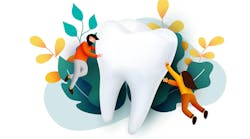PERSONALLY, I HAVE NEVER WALKED into a dental practice that also doubled as a bank. Nor have I seen a dental office that shared any office space with a bank. However, in considering the biggest mistakes that I have seen dentists make in the past two decades, treating a dental practice like a bank has been one of the biggest blunders by far.
Consider this scenario: Your patient walks in for an implant. You do the work and charge the patient $3,000. At the front desk, the patient puts down $500 and walks out still owing $2,500. You put it on the books and schedule monthly payments from the patient. Eventually, after six months, you have all of the money you were owed at the time of service.
As the old esurance commercial says, “That’s not how this works. That’s not how any of this works.”
You see, your dental practice was created as a business to help improve the oral health of your patients. It was not created to be a business where patients owed you money for extended periods of time. That’s why CareCredit and other patient financing services were created. These businesses help your patients afford the care they deserve if they are having financial difficulties. Your job is oral health. Their job is financing.
Yet so many dental practices seem to be in the financing business. There’s nothing wrong with taking pity on a patient who can’t pay for everything all at once. But there is something wrong with letting a patient walk out the door without having a solid plan to have the bill paid in a timely manner.
Your accounts receivable (A/R) tells a story. It tells how big of a bank your dental practice has become, especially when you look at the amount of money that is owed to your practice after more than 90 days from the date of service.
Let's look at trends in A/R more closely and see what we can learn.
Accounts receivable: The national average
What is the amount of A/R that the average dental practice has had on its books for more than 90 days? How does the average practice’s A/R compare to gross production? To find out, we took data from Sikka Software over the last seven years (tables 1 and 2). The data has been collected by Sikka Software from more than 12,500 dental practices across the United States.
Here are the numbers:
Table 1: Average A/R greater than 90 days for a dental practice
2011 – $41,111.14
2012 – $48,579.92
2013 – $51,584.39
2014 – $52,571.54
2015 – $49,598.06
2016 – $47,736.21
Table 2: Average A/R to gross production for dental practices
2011 – 78.29%
2012 – 85.28%
2013 – 92.98%
2014 – 98.66%
2015 – 101.27%
2016 – 94.79%
Taking control of A/R
Do you know what your A/R of more than 90 days is? Do you know how it compares to your overall gross production? These are key numbers for any dentist to know. After all, they directly affect the health of your business.
How can dentists cut down on A/R in their practices? Andy Cleveland, dubbed as the "A/R Ninja," has some advice. Below, he gives 10 pieces of advice to help you reduce A/R.
Tips from Andy Cleveland
1. Pre-estimate insurance, but do so by overestimation. If a your practice is going to make a mistake, make it on the higher end so that you are sending refunds instead of statements. Who doesn't like to get paid by their dentist?
2. Offer a prepaid discount. Offer a discount if patients pay when they schedule their appointments (prepay. Or, give a discount if they pay by check or cash—and you won't have to pay merchant card fees. Make it appealing for the patient to pay ahead of time. Even if your profitability decreases a little, it is nominal compared to what you would lose by having uncollectible A/R on your books.
3. Ask for payment in full at check out. Regardless of your staff's perception of whether the patient has the money or not, have them ask for full payment. They will be amazed at how many people will pay just by asking, and it gets easier with each occurrence, as patients realize payment is expected at the time of service.
Furthermore, you can motivate your staff by giving them an incentive based on collections or another key metric. Just saying thank you and communicating to your staff how much you appreciate them can be a game changer too. (Note: If you’d like a sample script, drop me a line at [email protected].)
4. Offer different forms of financing. Use two or three different companies to help finance the patient, but also prepare to make a payment plan with patients in-house, as they may not qualify for traditional financing. Doing this selectively will create patient loyalty and allow them to accept the treatment that they need, which will boost your case acceptance. By doing this, you elevate the patient's needs over your own, and they are more likely to stay with you and refer.
5. Bill frequently—the more the better. Consider billing on a net-15 or net-10 basis instead of the customary practice of waiting 30 days. The squeaky wheel gets the grease, and by being more top of mind than patients' other monthly obligations, you will naturally get more payments.
6. Consider contacting your patients using their preferred media. Some patients prefer mail, some prefer call, some prefer text, and so on. Do what is most convenient for the patient. Also, having a payment portal on your website is a huge bonus, allowing patients to pay you 24/7 without having to call in or forgetting to mail a check. No embarrassment, just payments.
7. Have different staff members call your patient. If your patient relates well to a hygienist, front-desk person, insurance coordinator, or another staff memeber, have these individuals call patients, connect with them, and get paid. Different patients will react better to a different personality types, so utilize this to your advantage.
8. Hire a company to do a lot of the contacting for you—so you are not the "money-hungry" dentist. If you find your staff is contacting your patients frequently, it's time to outsource and let someone else be the bad guy. This is what my company does. We help dentists' offices stick to what they do best. There are a million things that dental staff members can do with their time that is more profitable than constantly chasing money.
9. Connect emotionally with the patient. If a patient sees you as family, a friend, or as an integral part of their health-care regimen, they are more likely to pay you rather than think of you as just another vendor or company that they owe.
10. Smile and be friendly. Kindness goes a long way. Talking to them with real empathy shows that you place a high value on the relationship. This will have a tremendous effect on your bottom line.
The takeaway
Know your numbers, then start implementing the right strategies. With a few changes, your business can start being more like a dental practice—and less like a bank!
Author's note: Want to learn more about what Sikka Software can do for your practice? Practice Mobilizer is the free app that lets you send HIPAA-compliant video messages to patients, track patient arrival times, provide zip code–specific fee data, and more. Learn more about Sikka Software's Practice Mobilizer app at practicemobilizer.com.
Additional articles by Kevin Henry:
At $116,000, average accounts receivable for dental practices up 36% since 2011
Here's the current net production per hour dollar amount for dentists—and where the trend is headed
Here's the average number of single crowns dentists are placing (and where the trend is headed)
For the most current dental headlines, click here.
About the Author

Kevin Henry
Cofounder, IgniteDA.net
With more than 20 years in the dental publishing industry, Kevin Henry is the former group editorial director for Dental Products Report and managing editor for Dental Economics. Currently, he is the editor-in-chief for DrBicuspid.com. He has spoken to dental assistants throughout the world, in person and through the Dental Assistant Nation podcast series, reminding them of the important role they play every day in their practice. He is also certified as a DiSC trainer, helping dental practices learn how to understand each other better through personality assessments and training.






